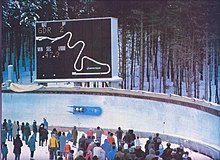Sarajevo Olympic Bobsleigh and Luge Track
In June 2014, restoration began on the track, including the removal of overgrowth and graffiti, and the application of a protective coating from Start 1 down to the bottom of the course.
The track complex was designed by architect Gorazd Bučar,[8] with a vision for both reduced footprint of the facility, and flexible and adaptable use as a piece of Olympic Legacy Infrastructure.
"[2] The top section, known as 'Course 1', begins at the upper start house and runs 350 meters (1,150 ft), splitting from the main track at turn 3.
[10] Beginning in 2014, following an extensive demining operation, limited renovations began-preparing the site for summer training with a grant from the International Luge Federation.
However, the ultimate goal is to return the track to fully serviceable condition for hosting future sliding competitions and training teams from around the world.
[13][6] In April 2022, the Government of the Sarajevo Canton appointed a team to develop a plan for the revitalization and reconstruction of the entire facility as part of Barcelona's potential bid for the 2030 Winter Olympic Games.


